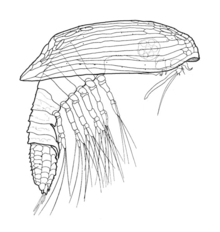Facetotecta
| Facetotecta | |
|---|---|
 | |
| Y-cyprid | |
| Scientific classification | |
| Kingdom: | Animalia |
| Clade: | Euarthropoda |
| Subphylum: | Crustacea |
| Class: | Maxillopoda |
| Infraclass: | Facetotecta Grygier, 1985 |
| Family: | Hansenocarididae Itô, 1985 |
| Genus: | Hansenocaris Itô, 1985 |
| Species | |
|
See text | |
Facetotecta is a poorly known infraclass of thecostracan crustaceans. The adult forms have never been recognised, and the group is known only from its larvae, the "y-nauplius" and "y-cyprid" larvae.[1] They are mostly found in the north Atlantic Ocean, neritic waters around Japan,[2] and the Mediterranean Basin, where they also survive in brackish water.[3]
History
The German zoologist Christian Andreas Victor Hensen first collected facetotectans from the North Sea in 1887, but assigned them to the copepod family Corycaeidae; later Hans Jacob Hansen named them "y-nauplia", assuming them to be the larvae of unidentified barnacles.[4] More recently, it has been suggested that, since there is a potential gap in the tantulocarid life cycle, y-larvae may be the larvae of tantulocarids. However, this would be "a very tight fit", and it is more likely that the adult forms have not yet been seen.[1] Genetic analysis using 18S ribosomal DNA reveal Facetotecta to be the sister group to the remaining Thecostraca (Ascothoracida and Cirripedia).[5]
Life cycle
Nauplius
Y-nauplii are 250–620 micrometres (0.010–0.024 in) long,[1] with a faceted cephalic shield, from which the group derives its name.[6] The abdomen is relatively long, and also ornamented.[1] In common with other thecostracans, Facetotecta pass through five naupliar instars before undergoing a single cyprid phase.[4]
Cyprid
The presence of a distinctive cyprid larva indicates that the Facetotecta is a member of the Thecostraca. A number of species have been described on the basis of a y-cyprid alone.[7] As in barnacles, the cyprid is adapted to seeking a place to settle as an adult. It has compound eyes, can walk using its antennae, and is capable of producing an adhesive glue.[8]
Juvenile
In 2008, a juvenile form was produced by treating y-larvae with the hormone 20-hydroxyecdysone, which stimulated ecdysis and the transition to the next life phase. The resulting animal, named the ypsigon, was slug-like, apparently unsegmented, and limbless.[8][9]
Adults
While they have never been seen, the adult facetotectans are almost certainly endoparasites of other animals, some of which are likely to be inhabitants of coral reefs.[10]
Species
Eleven species are currently recognised,[2] while one species which is assigned to Hansenocaris – H. hanseni (Steuer, 1905) – is of uncertain affinities:[4]
- Hansenocaris acutifrons Itô, 1985
- Hansenocaris corvinae Belmonte, 2005
- Hansenocaris furcifera Itô, 1989
- Hansenocaris itoi Kolbasov & Høeg, 2003
- Hansenocaris leucadea Belmonte, 2005
- Hansenocaris mediterranea Belmonte, 2005
- Hansenocaris pacifica Itô, 1985
- Hansenocaris papillata Kolbasov & Grygier, 2007
- Hansenocaris rostrata Itô, 1985
- Hansenocaris salentina Belmonte, 2005
- Hansenocaris tentaculata Itô, 1986
References
- 1 2 3 4 Joel W. Martin; George E. Davis (2001). An Updated Classification of the Recent Crustacea (PDF). Natural History Museum of Los Angeles County. p. 132.
- 1 2 Daphne Cuvelier (April 4, 2005). "Hansenocaris Itô, 1985". World Register of Marine Species.
- ↑ Genuario Belmonte (2005). "Y-nauplii (Crustacea, Thecostraca, Facetotecta) from coastal waters of the Salento Peninsula (south eastern Italy, Mediterranean Sea) with descriptions of four new species". Marine Biology Research. 1 (4): 254–266. doi:10.1080/17451000500202518.
- 1 2 3 E. A. Ponomarenko (2006). "Facetotecta – Unsolved Riddle of Marine Biology". Russian Journal of Marine Biology. 32 (Suppl. 1): S1–S10. doi:10.1134/S1063074006070017.
- ↑ Marcos Pérez-Losada; Jens T. Høeg; Gregory A. Kolbasov; Keith A. Crandall (2002). "Reanalysis of the relationships among the Cirripedia and the Ascothoracida and the phylogenetic position of the Facetotecta (Maxillopoda: Thecostraca) using 18S rDNA sequences". Journal of Crustacean Biology. 22 (3): 661–669. doi:10.1651/0278-0372(2002)022[0661:ROTRAT]2.0.CO;2.
- ↑ Christopher Taylor (February 23, 2008). "The secret of y-larvae". Catalogue of Organisms.
- ↑ Gregory A. Kolbasov; Mark J. Grygier; Viatcheslav V. Ivanenko; Alejandro A. Vagelli (2007). "A new species of the y-larva genus Hansenocaris Itô, 1985 (Crustacea: Thecostraca: Facetotecta) from Indonesia, with a review of y-cyprids and a key to all their described species" (PDF). Raffles Bulletin of Zoology. 55 (2): 343–353.
- 1 2 Gerhard Scholtz (2008). "Zoological detective stories: the case of the facetotectan crustacean life cycle". Journal of Biology. 7 (5): 16. doi:10.1186/jbiol77. PMC 2447532. PMID 18598383.
- ↑ Henrik Glenner; Jens T. Høeg; Mark J. Grygier; Yoshihisa Fujita (2008). "Induced metamorphosis in crustacean y-larvae: Towards a solution to a 100-year-old riddle". BMC Biology. 6: 21. doi:10.1186/1741-7007-6-21.
- ↑ Mark Grygier; Jens T. Høeg; Yoshihisa Fujita (July 2004). Introduction to the tremendous diversity of y-larvae (Crustacea: Maxillopoda: Thecostraca: Facetotecta) in inshore coral reef plankton at Sesoko Island, Okinawa, Japan (PDF). 10th International Coral Reef Symposium. Biodiversity and Diversification in the Indo-West Pacific. Okinawa, Japan. Archived from the original (PDF) on 2011-06-11.